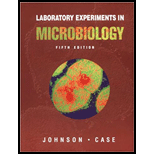
How do agglutination tests detect microbes in a patient’s blood or fluids differ from techniques to detect antibodies to microbes in a patient’s serum?
To analyze:
The difference between the normal immunoassays that detect microbes in patient's serum and agglutination tests detecting microbes in patient's blood or fluids.
Introduction:
Immunoassays:
Immunoassays are techniques that are performed to detect the presence of an antibody in a patient's serum with respect to a known antigen of a pathogen or to detect the presence of a disease causing antigen corresponding to a known antibody.
Latex Agglutination test:
It is a type of agglutination test used to detect the presence of an antigen or an antibody in a patient's body fluids with respect to a particular diseased condition. Examples of body fluids- Blood, Saliva, Urine, Cerebrospinal fluid etc.
Explanation of Solution
ELISA (Enzyme Linked ImmunoSorbent Assay) is one of the widely used Immunoassays that detect the presence of antigen or antibody in a patient's serum. The technique involves coating the well of the microtiter plate with antigen and adding primary antibody (known antibody that binds to the antigen of the pathogen) .The secondary antibody labelled with an enzyme is added to which a chromogenic substrate is introduced. If there is antigen-antibody interaction the colour change of the product produced indicates the endpoint.
Latex Agglutination test or Latex fixation is a technique in which the antigen from the patient's fluid is mixed with antibody coated latex particles. If antigen-antibody interaction is present, then these latex particles gets agglutinated and large lattices formation is seen due. Due to the sedimentation of these large sized lattices, clumps are formed and are visible to naked eye within few minutes. The advantages of using this technique are quick, consistent, uniform and stable results. However getting false results due to interfering substances is a demerit.
Hence the difference between Immunoassays and Latex agglutination test was analysed.
Want to see more full solutions like this?
Chapter 42 Solutions
Symbiosis, Lab Experiments in Microbiology
- Answer number seven do what it says.arrow_forwardWhich of the following is the process that is "capable of destroying all forms of microbial life"? Question 37 options: Surgical scrub Sterilization Chemical removal Mechanical removalarrow_forwardAfter you feel comfortable with your counting method and identifying cells in the various stages of mitosis, use the four images below of whitefish blastula to count the cells in each stage until you reach 100 total cells, recording your data below in Data Table 1. (You may not need to use all four images. Stop counting when you reach 100 total cells.) After totaling the cells in each stage, calculate the percent of cells in each stage. (Divide total of stage by overall total of 100 and then multiply by 100 to obtain percentage.) Data Table 1Stage Totals PercentInterphase Mitosis: Prophase Metaphase Anaphase Telophase Cytokinesis Totals 100 100% To find the length of time whitefish blastula cells spend in each stage, multiply the percent (recorded as a decimal, in other words take the percent number and divide by 100) by 24 hours. (Example: If percent is 20%, then Time in Hours = .2 * 24 = 4.8) Record your data in Data…arrow_forward
- What are Clathrin coated vesicles and what is their function?arrow_forwardHow is a protein destined for the Endoplasmic Reticulum (ER), imported into the ER? Be concise.arrow_forwardFind out about the organisations and the movements aimed at the conservation of our natural resources. Eg Chipko movement and Greenpeace. Make a project report on such an organisation.arrow_forward
- What are biofertilizers and mention the significancearrow_forwardPCBs and River Otters: Otters in Washington State’s Green-Duwamish River have high levels of polychlorinated biphenyls (PCBs) in their livers. PCBs can bind to the estrogen receptors in animals and disrupt the endocrine system of these otters. The PCBs seem to increase the estrogen to androgen ratio, skewing the ratio toward too much estrogen. How would increased estrogen affect the river otter population? Based on your reading of the materials in this unit, what factors can affect fertility in humans? Explain how each of the factors affecting human fertility that you described can disrupt the human endocrine system to affect reproduction.arrow_forwardOther than oil and alcohol, are there other liquids you could compare to water (that are liquid at room temperature)? How is water unique compared to these other liquids? What follow-up experiment would you like to do, and how would you relate it to your life?arrow_forward
- Selection of Traits What adaptations do scavengers have for locating and feeding on prey? What adaptations do predators have for capturing and consuming prey?arrow_forwardCompetition Between Species What natural processes limit populations from growing too large? What are some resources organisms can compete over in their natural habitat?arrow_forwardSpecies Interactions Explain how predators, prey and scavengers interact. Explain whether predators and scavengers are necessary or beneficial for an ecosystem.arrow_forward
 Human Biology (MindTap Course List)BiologyISBN:9781305112100Author:Cecie Starr, Beverly McMillanPublisher:Cengage LearningEssentials of Pharmacology for Health ProfessionsNursingISBN:9781305441620Author:WOODROWPublisher:Cengage
Human Biology (MindTap Course List)BiologyISBN:9781305112100Author:Cecie Starr, Beverly McMillanPublisher:Cengage LearningEssentials of Pharmacology for Health ProfessionsNursingISBN:9781305441620Author:WOODROWPublisher:Cengage Human Physiology: From Cells to Systems (MindTap ...BiologyISBN:9781285866932Author:Lauralee SherwoodPublisher:Cengage LearningSurgical Tech For Surgical Tech Pos CareHealth & NutritionISBN:9781337648868Author:AssociationPublisher:Cengage
Human Physiology: From Cells to Systems (MindTap ...BiologyISBN:9781285866932Author:Lauralee SherwoodPublisher:Cengage LearningSurgical Tech For Surgical Tech Pos CareHealth & NutritionISBN:9781337648868Author:AssociationPublisher:Cengage





